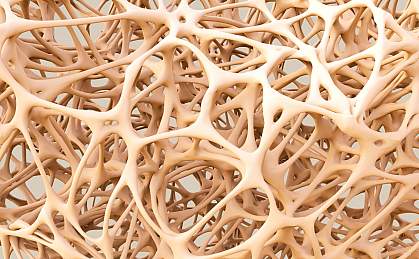You are here
April 2, 2019
3D-printed bioreactor builds bone
At a Glance
- Bioengineers repaired jawbones in sheep with tissue grown in a 3D-printed bioreactor.
- The findings lay the groundwork for developing and testing the approach in people.

The jawbone is a particularly difficult site for a surgeon to repair after an injury, cancer, or bone infection. Usually, a damaged part is replaced with healthy tissue from the calf bone. The surgeon needs to remove a piece of calf bone large enough to shape into the void in the jaw.
Tissue engineers have been developing ways to replace bone using tissue grown in devices called bioreactors. These devices can coax cells to grow into 3D shapes using certain growth factors. Bioreactors can work inside or outside of the body as long as the right cells and growth factors are present. They can also be printed in different shapes to match specific wounds.
A team of researchers led by Dr. Antonios G. Mikos of Rice University set out to use 3D printing to create bioreactors that could form bone tissue into precise shapes to heal jaw defects. Their study appeared on March 18, 2019, in the Proceedings of the National Academy of Sciences. The research was supported in part by NIH’s National Institute of Biomedical Imaging and Bioengineering (NIBIB).
Using a 3D printer, the researchers created hollow rectangular bioreactors. The team packed them to test both natural or synthetic materials as the matrix for cells to grow into precise 3D shapes of bone tissue. They filled 15 bioreactors with crushed rib bone and nine with a synthetic bone matrix.
Next, they implanted the 24 bioreactors onto the ribs of six female sheep with jaw defects. Ribs have a sleeve around them that’s enriched with the cells and growth factors needed to generate bone. Ribs also are easy for a surgeon to access, and the many ribs enable several devices to be implanted at the same time.
At the same time, surgeons used temporary material to fill the voids in the jawbones. This helped prepare the sheep's jaws for the eventual implantation of the new bone tissue.
Nine weeks later, 83% of the 24 bioreactors were suitable for transfer to the jaw. Both the natural and synthetic materials generated solid tissue. There were no significant differences between the materials in bone density, bone height, bony surface area, or mineralized surface area. The natural materials were slightly stronger and more mature, so the team replaced the temporary material in the jawbone with the newly formed natural bioreactor tissue.
Twelve weeks later, the researchers analyzed whether the new tissue had integrated into the sheep jaws. The bioreactor-generated tissue bridged with the native jawbone in five of the six sheep.
“A major innovation of this work is leveraging a 3D-printed bioreactor to form bone grown in another part of the body while we prime the defect to accept the newly generated tissue,” Mikos says.
This study demonstrates a bone reconstruction approach that works in large animals with materials known to be safe. The research paves the way for human studies. Because the natural and synthetic materials formed similar bone tissue, future studies may use synthetic material as a source of bone matrix to avoid the need to harvest the patient’s own bone.
—by Geri Piazza
Related Links
- Printed Scaffolds Promote Spinal Cord Repair in Rats
- 3-D Cell Placenta Model Mimics Development, Microbial Resistance
- Bioengineered Blood Vessel Grafts Grow in Animals
- Lab-Grown Kidneys Function in Rats
- Tissue Engineering and Regenerative Medicine
- Biomaterials
- Tissue Engineering & Regenerative Medicine Research Program
References: Biomaterials-aided mandibular reconstruction using in vivo bioreactors. Tatara AM, Koons GL, Watson E, Piepergerdes TC, Shah SR, Smith BT, Shum J, Melville JC, Hanna IA, Demian N, Ho T, Ratcliffe A, van den Beucken JJJP, Jansen JA, Wong ME, Mikos AG. Proc Natl Acad Sci U S A. 2019 Mar 18. pii: 201819246. doi: 10.1073/pnas.1819246116. [Epub ahead of print]. PMID: 30886100.
Funding: NIH’s National Institute of Biomedical Imaging and Bioengineering (NIBIB), National Institute of Dental and Craniofacial Research (NIDCR), and National Institute of Arthritis and Musculoskeletal and Skin Diseases (NIAMS); U.S. Army Medical Research and Materiel Command; Office of Naval Research; Air Force Medical Service; Department of Veterans Affairs Office of Research and Development; Office of the Assistant Secretary of Defense for Health Affairs; Osteo Science Foundation; Barrow Scholars Program, and the Robert and Janice McNair Foundation.
